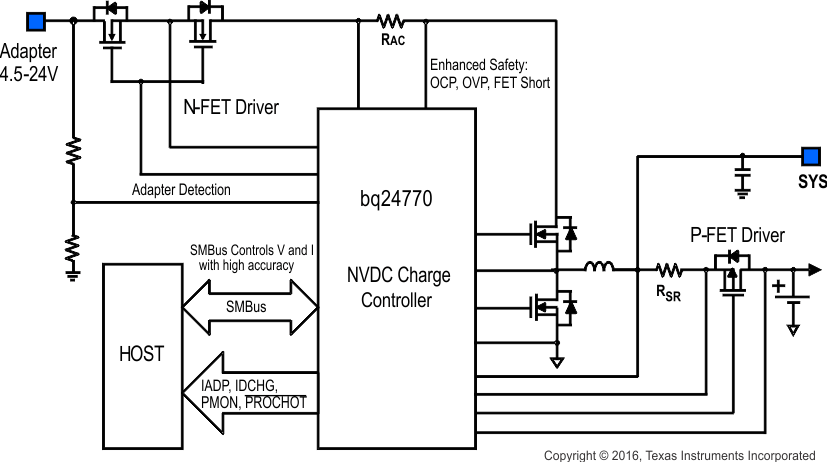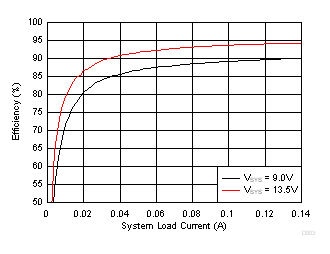SLUSC03C August 2014 – December 2016
PRODUCTION DATA.
- 1 Features
- 2 Applications
- 3 Description
- 4 Revision History
- 5 Device Comparison Table
- 6 Pin Configuration and Functions
- 7 Specifications
-
8 Detailed Description
- 8.1 Overview
- 8.2 Functional Block Diagram
- 8.3 Feature Description
- 8.4 Device Functional Modes
- 8.5 Programming
- 8.6 Register Maps
- 9 Application and Implementation
- 10Power Supply Recommendations
- 11Layout
- 12Device and Documentation Support
- 13Mechanical, Packaging, and Orderable Information
Package Options
Mechanical Data (Package|Pins)
- RUY|28
Thermal pad, mechanical data (Package|Pins)
Orderable Information
1 Features
- Host-controlled NVDC-1 1S-4S Battery Charge Controller with 4.5-24 V Input Range
- Support SMBus (bq24770) and I2C (bq24773)
- System Instant-on Operation with no Battery or Deeply Discharged Battery
- Supplement Mode with Synchronous BATFET Control when Adaptor is fully loaded
- Ultra Fast Input Current DPM at 100 μs
- Ultra Low Quiescent Current of 600 µA and High PFM Light Load Efficiency >80% at 20 mA Load to Meet Energy Star and ErP Lot6.
- High Accuracy Power / Current Monitor for CPU Throttling
- Comprehensive PROCHOT Profile
- Input and Battery Current Monitor (IADP/IBAT)
- System Power Monitor (PMON)
- Programmable Input Current Limit, Charge Voltage, Charge Current and Minimum System Voltage Regulation
- ±0.5% Charge Voltage (16 mV/step)
- ±2% Input/charge Current (64 mA/step)
- ±2% 40x Input / 16x Discharge / 20x Charge Current Monitor
- Support Battery LEARN Function
- High Integration
- NMOS ACFET and RBFET Driver
- PMOS battery FET Gate Driver
- Internal Loop Compensation
- Independent Comparator
- Automatic Trickle Charge to Wake up Gas Gauge
- 600kHz to 1.2MHz Programmable Switching Frequency
2 Applications
- Ultrabook, Notebook, Detachable, and Tablet PC
- Handheld Terminal
- Industrial, Medical, Portable Equipment
3 Description
The bq2477x is high-efficiency, synchronous, NVDC-1 battery charge controllers, offering low component count for space-constraint, multi-chemistry battery charging applications.
The power path management allows the system to be regulated at battery voltage but does not drop below system minimum voltage (programmable). With this feature, the system keeps operating even when the battery is completely discharged or removed. The power path management allows the battery to provide supplement current to the system to keep the input supply from being overloaded.
The bq2477x provides drivers and power path management for N-channel ACFET and reverse blocking FET. The devices provides driver to control NVDC operation of external P-channel battery FET. It also drives high-side and low-side MOSFETs of the switching regulator.
The bq2477x monitors adapter current (IADP), battery charge/discharge current (IBAT) and system power (PMON). The flexibly programmed PROCHOT output goes directly to CPU for throttle back when needed.
Device Information(1)
| PART NUMBER | PACKAGE | BODY SIZE (NOM) |
|---|---|---|
| bq24770 | WQFN (28-Pin) | 4.00mm x 4.00mm2 |
| bq24773 |
- For all available packages, see the orderable addendum at the end of the data sheet.
space
space

